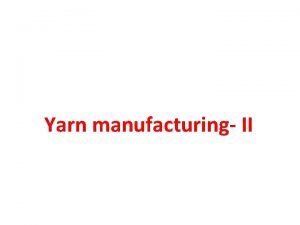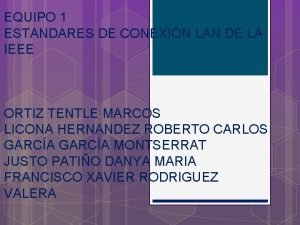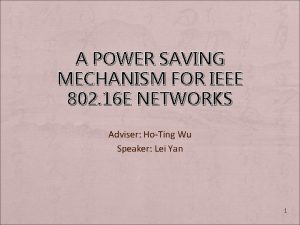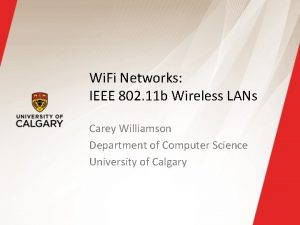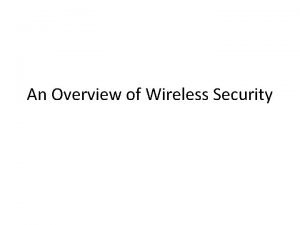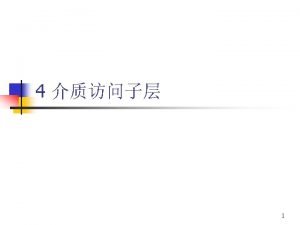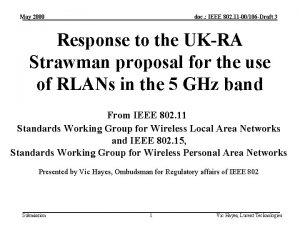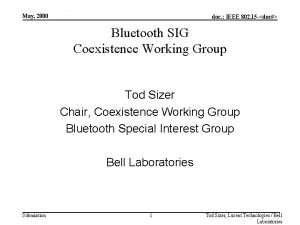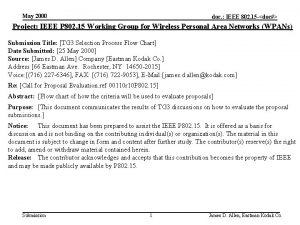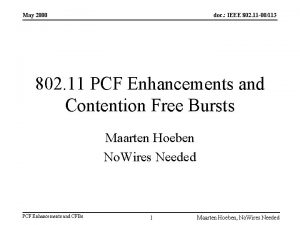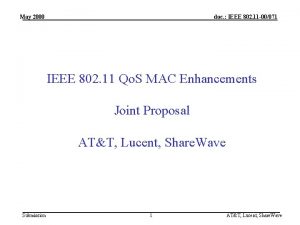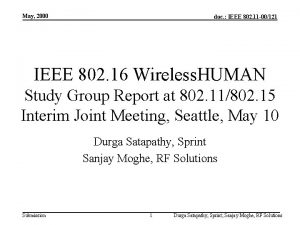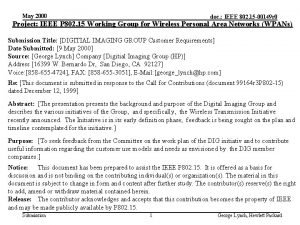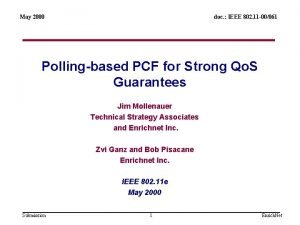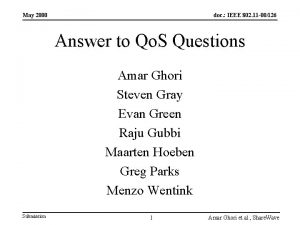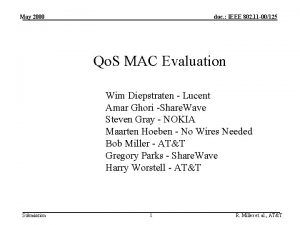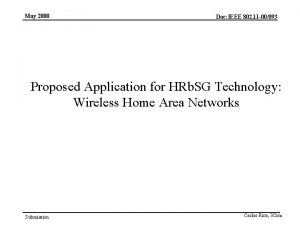May 2000 doc IEEE 802 11 00106 Draft

















- Slides: 17

May 2000 doc. : IEEE 802. 11 -00/106 -Draft 1 IEEE 802. 11's response to the Strawman proposal Submission 1 Copyright, 1996 © Dale Carnegie & Associates, Inc. Vic Hayes, Lucent Technologies

May 2000 doc. : IEEE 802. 11 -00/106 -Draft 1 100 MHz Spectrum available for 8 + 2 years…. unused Yet, the Strawman allocates 100 MHz uniquely to HIPERLAN/1 for another 2 years For what usage? Search on the internet: one announcement for a product in April 1999 no product yet one website: HIPERLAN/1 alliance evidence of a single meeting in May 1999 Submission 2 Vic Hayes, Lucent Technologies

May 2000 doc. : IEEE 802. 11 -00/106 -Draft 1 Observations supporting removal of HIPERLAN/1 • Spectrum is not used for 8 years – In 1992 Spectrum was assigned for HIPERLAN (Recommendation T/R 22 -06, Madrid 992). – The standard was published October 1996 as ETS 300 652. • Standard is available for about 4 years, no products are available yet Submission 3 Vic Hayes, Lucent Technologies

May 2000 doc. : IEEE 802. 11 -00/106 -Draft 1 Observations supporting removal of HIPERLAN/1 • No products on the market – April 1999 one company announced HIPERLAN/1 product – To date there is still no product actually available – There is a single page website with HIPERLAN 1 as title. No products mentioned. • Is it really required to reserve 100 MHz of spectrum for another 2 years? Submission 4 Vic Hayes, Lucent Technologies

May 2000 doc. : IEEE 802. 11 -00/106 -Draft 1 Conclusion for 5150 -5250 MHz band • HIPERLAN Type 1 support is a continued underutilization of spectrum. • 802. 11 supports addition of 802. 11 a and HIPERLAN type 2, but to remove HIPERLAN type 1 Submission 5 Vic Hayes, Lucent Technologies

May 2000 doc. : IEEE 802. 11 -00/106 -Draft 1 Recommendation 1 • Remove “HIPERLAN/1” from the 5150 -5250 MHz Submission 6 Vic Hayes, Lucent Technologies

May 2000 doc. : IEEE 802. 11 -00/106 -Draft 1 Proposal to discontinue HIPERLAN/0 • Support from IEEE 802. 11 provided: – The use of the spectrum is under some level of control to protect against interference from non-high-data-rate applications. – This could be done by limiting the use to devices conforming to recognised standards, with a clear scope of high data rates such as HIPERLAN/2, 802. 11, and so on Submission 7 Vic Hayes, Lucent Technologies

May 2000 doc. : IEEE 802. 11 -00/106 -Draft 1 Recommendation 2 • Make current allocation of the 5150 -5250 MHz only for ”HIPERLAN/2 and IEEE 802. 11 a” devices • Do a regular review if more standards have met certain requirements Submission 8 Vic Hayes, Lucent Technologies

May 2000 doc. : IEEE 802. 11 -00/106 -Draft 1 Licensed Spectrum? • Agree with the considerata • Agree with the need for licensed spectrum • But not in the 455 MHz allocated to HIPERLAN/2 and 802. 11 a – removal of the spectrum from the license exempt use will result in unacceptable performance and thus capacity degrades – Note that the 455 MHz does include spectrum used by radars. • A typical wideband radar used more than 100 MHz – HIPERACCESS is a typical licensed band application – has been moved outside the 5 GHz range Submission 9 Vic Hayes, Lucent Technologies

May 2000 doc. : IEEE 802. 11 -00/106 -Draft 1 Conserve spectrum for license exempt – High data rates require a large signal margin and this in turn limits the tolerance for interference – including interference from the same system. – For example, the re-use factor for the 54 Mb/s mode range is 67 – which means that 67 channels are needed to achieve the full 54 Mb/s on each channel in an arbitrarily large system – If there are fewer channels the interference among channels will be larger and the maximum data rate can not be achieved Submission 10 Vic Hayes, Lucent Technologies

May 2000 doc. : IEEE 802. 11 -00/106 -Draft 1 Conserve spectrum for license exempt – Therefore a large number of channels is needed to assure adequate capacity in high density systems – The current 18 channels are about enough for most situations but we are at the cusp of the performance curve and further reduction will result in unacceptable performance. HIPERLANs have always been positioned as user owned and operated. Submission 11 Vic Hayes, Lucent Technologies

May 2000 doc. : IEEE 802. 11 -00/106 -Draft 1 Conserve spectrum for license exempt • band partitioning is per definition wasteful notably in short range systems like wireless LANs: – in many cases, the “licensed“ spectrum would go unused even though there is an operator in sight. – the places where an operator may want to provide services is not necessarily one where the private use is very dense. So, partitioning for these reasons leads to unused spectrum Submission 12 Vic Hayes, Lucent Technologies

May 2000 doc. : IEEE 802. 11 -00/106 -Draft 1 Alternative to licensed service • A better way may be found to give service providers some priority to use certain channels – eg. by allowing them not to employ DFS (whereas user owned and operated systems would be required to employ DFS) Submission 13 Vic Hayes, Lucent Technologies

May 2000 doc. : IEEE 802. 11 -00/106 -Draft 1 Recommendation 3 • Allocate the entire band 5570 -5725 MHz to licensed exempt • Consider to exempt service providers from the requirement to use DFS for certain channels Submission 14 Vic Hayes, Lucent Technologies

May 2000 doc. : IEEE 802. 11 -00/106 -Draft 1 Summary • Remove “HIPERLAN/1” from the 5150 -5250 MHz • Make current allocation of the 5150 -5250 MHz only for ”HIPERLAN/2 and IEEE 802. 11 a” devices • Do a regular review if more standards have met certain requirements Submission 15 Vic Hayes, Lucent Technologies

May 2000 doc. : IEEE 802. 11 -00/106 -Draft 1 Summary (2) • Allocate the entire band 5570 -5725 MHz to licensed exempt • Consider to exempt service providers from the requirement to use DFS for certain channels Submission 16 Vic Hayes, Lucent Technologies

May 2000 doc. : IEEE 802. 11 -00/106 -Draft 1 Proposed Band plan Submission 17 Vic Hayes, Lucent Technologies


